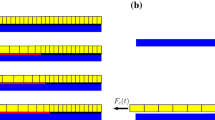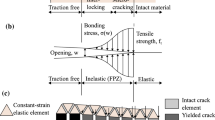Abstract
In the preceding companion paper (Bažant and Li, 1995), the solution of an aging viscoelastic law was structure containing a cohesive crack with a rate-dependent stress-displacement softening law was reduced to a system of one-dimensional integro-differential equations involving compliance functions for points on the crack faces and the load point. An effective numerical algorithm for solving these equations, which dramatically reduces the computer time compared to the general two-dimensional finite element solution, is presented. The behavior of the model for various loading conditions is studied. It is shown that the model can closely reproduce the available experimental data from fracture tests with different loading rates spanning several orders of magnitude, and tests with sudden changes of the loading rate. Influence of the loading rate on the size effect and brittleness is also analyzed and is shown to agree with experiments.
Similar content being viewed by others
References
Bažant, Z.P. (1985). Fracture mechanics and strain-softening in concrete. In U.S.-Japan Seminar on Finite Element Analysis of Reinforced Concrete Structure (held in Tokyo, published by ASCE, New York) 1, 47–69.
Bažant, Z.P. (1993). Scaling laws in mechanics of failure. Journal of Engineering Mechanics ASCE 119(9), 1828–1844.
Bažant, Z.P. (1995). Scaling of quasibrittle fracture and the fractal question. ASME Journal of Materials and Technology 117, 361–367 (Materials Division Special 75th Anniversary Issue).
Bažant, Z.P. (1997). Scaling of quasibrittle fracture: Asymptotic analysis. International Journal of Fracture 83(1), 19–40.
Bažant, Z.P., Bai, S.-P. and Gettu, R. (1993). Fracture of rock: Effect of loading rate. Engineering Fracture Mechanics 45, 393–398.
Bažant, Z.P., and Chern, J.-C. (1985). Strain-softening with creep and exponential algorithm. Journal of Engineering Mechanics ASCE 111(EM3), 391–415.
Bažant, Z.P., and Gettu, R. (1992). Rate effects and load relaxation: Static fracture of concrete. ACI Materials Journal 89, 456–468.
Bažant, Z.P., Gu, W.-H., and Faber, K.T. (1995). Softening reversal and other effects of a change in loading rate on fracture of concrete. ACI Materials Journal 92, 3–9.
Bažant, Z.P., and Jirásek, M. (1993). R-curve modeling of rate and size effects in quasibrittle fracture. International Journal of Fracture 62, 355–373.
Bažant, Z.P., and Kazemi, M.T. (1990). Size effect in fracture of ceramics and its use to determine fracture energy and effective process zone length. Journal of American Ceramic Society 73(7), 1841–1853.
Bažant, Z.P., and Li, Y.-N. (1997). Cohesive crack model with rate-dependent crack opening and viscoelasticity: Numerical method and behavior. International Journal of Fracture, 86, 247–265.
Bažant, Z.P., and Oh, B.H. (1983). Crack band theory for fracture of concrete. Material and Structures 16, 155–177.
Bažant, Z.P., Ožbolt, J. and Eligehausen, R. (1994). Fracture size effect: Review of evidence for concrete structures. Journal of Structural Engineering ASCE 120(8), 2377–2398.
de Borst, R. (1987). Smeared cracking, plasticity, creep and thermal loading — A unified approach. Computer Methods in Applied Mechanics and Engineering 62, 89–110.
Hillerborg, A., Modéer, M. and Petersson, P.-E. (1976). Analysis of crack formation and crack growth in concrete by means of fracture mechanics and finite elements. Cement and Concrete Research 6, 773–782.
Petersson, P.-E. (1981). Crack growth and development of fracture zones in plain concrete and similar materials, Doctoral Dissertation, Lund Institute of Technology, Sweden.
Tandon, S., Faber, K.T., Bažant, Z.P., and Li, Y-N. (1996). Cohesive crack modeling of influence of sudden changes in loading rate on concrete fracture. Engineering Fracture Mechanics 52(6), 987–997.
Tvergaard, V., and Hutchinson, J.W. (1991). Effect of T-stress on mode I crack growth resistance in a ductile solid. International Journal of Solids and Structures 31, 823–833.
Wu, Z.S., and Bažant, Z.P. (1993). ‘Finite element modeling of rate effect in concrete fracture with influence of creep’, in Proc., 5th Intern. RILEM Symp. on Creep and Shrinkage of Concrete (ConCreep 5, held in Barcelona). Edited by J. Carol and Z.P. Bažant, E. and F.N. Spon, London 427–432.
Author information
Authors and Affiliations
Rights and permissions
About this article
Cite this article
Li, YN., Bažant, Z.P. Cohesive Crack Model with Rate-Dependent Opening and Viscoelasticity: II. Numerical Algorithm, Behavior and Size Effect. International Journal of Fracture 86, 267–288 (1997). https://doi.org/10.1023/A:1007497104557
Issue Date:
DOI: https://doi.org/10.1023/A:1007497104557




